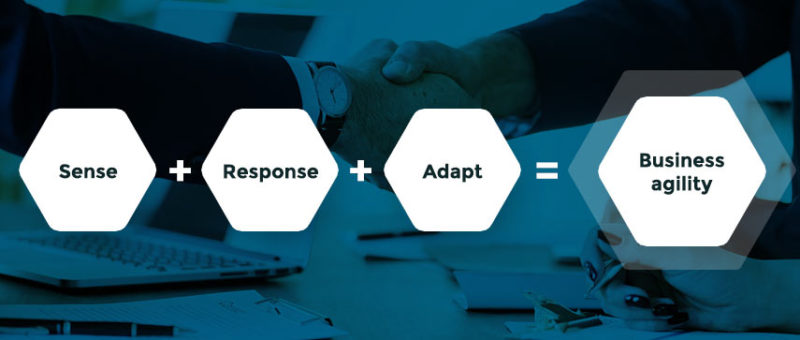
Agilemania
Agilemania, a small group of passionate Lean-Agile-DevOps consultants and trainers, is the most tru... Read more

Agilemania, a small group of passionate Lean-Agile-DevOps consultants and trainers, is the most tru... Read more

What is agility in business?
Business agility is the company’s ability to adapt to changing market conditions.
Business agility refers to distinct qualities that allow organizations to respond rapidly to changes in the internal and external environment without losing momentum or vision. Adaptability, flexibility, and balance are three qualities essential to long-term business agility.
Business agility is important for firms looking to survive long-term.

Please find below some of the factors influencing organizations on the path of Business Agility:
Join our Business Agility Foundation (ICP-BAF) Certification Training for a purpose-driven training session to adopt agile ways of working for enterprises.
One example of business agility in action is a company that specializes in manufacturing and selling a specific product.
The company has been successful for many years, but suddenly, a new competitor enters the market with a similar product that is more advanced and less expensive.
The company's sales begin to decline and they start to lose market share. In order to remain competitive and continue to grow, the company must be agile.
The company's management team quickly recognizes the threat and immediately begins to analyze the situation. They conduct market research to determine what the new competitor is doing differently, and what the company can do to improve its own product.
They also look at the company's internal processes to see if there are any areas that can be streamlined or made more efficient. The management team then implements a number of changes to improve the company's product and internal processes.
They invest in new technology to improve the manufacturing process, which allows them to produce the product more efficiently and at a lower cost. They also redesigned the product to make it more advanced and appealing to customers.
The company also starts to focus on customer needs and wants and works to build stronger relationships with its clients. They begin to offer custom solutions and services to meet the unique needs of each customer.
They also work to improve their communication with customers and make sure they are providing excellent customer service.
Finally, the company starts to focus on marketing and advertising to promote their new and improved product. They develop new marketing campaigns and start to advertise their product on various platforms.
As a result of these changes, the company is able to adapt quickly and efficiently to the new market conditions and remain competitive.
They are able to continue to grow and increase their market share, even with the new competitors in the market. This is an example of business agility in action.
Continue reading to get an understanding of how to implement business agility, and what are its benefits in any organization.
The agility in business is important to adapt to changing market conditions and customer needs, as well as to respond quickly to new opportunities and challenges. This can lead to increased competitiveness, improved customer satisfaction, and greater profitability.
Additionally, sustainable business agility can help a company reduce its environmental footprint and promote social responsibility, which can enhance its reputation and build long-term customer loyalty.
Overall, building sustainable business agility can be a key factor in ensuring the long-term success and growth of a business.
Find below a few key traits for building Sustainable Business Agility:
Growth Mindset
Self-Organizing
Strength-Based
Purpose Centered
Emotional Intelligence and Mindfulness
Business agility can be achieved through a combination of streamlined processes, flexible technologies, and a culture of continuous improvement. The benefits of business agility are numerous and include increased competitiveness, improved customer satisfaction, and enhanced employee engagement, among many others.
Sustainable business agility allows an organization to stay ahead of the curve and maintain a competitive edge in the marketplace.
Furthermore, an agile culture fosters a sense of ownership and empowerment among employees, which leads to increased engagement and motivation.
Overall, business agility is a crucial aspect of modern business that allows companies to stay competitive, responsive, and innovative in today's fast-paced business environment.
Business agility contributes to:
Agile tools play a crucial role in implementing business agility by providing a framework for efficient and effective collaboration, communication, and project management. Some of the key benefits of using agile tools include:
Overall, agile tools play a critical role in implementing business agility by providing a framework for efficient and effective collaboration, communication, and project management.
Agilemania, a small group of passionate Lean-Agile-DevOps consultants and trainers, is the most trusted brand for digital transformations in South and South-East Asia.
WhatsApp Us
Sumeet is an excellent coach and can relate the subject to the day-to-day work we do. That makes our understanding easie...
I attended PSPO Training by Sumeet Madan last wakened and I must say it has been the best training ever. He did not open...

I had recently attended PSPO training with Sumeet Madan and it was fantastic! His expertise in Agile product ownership i...

Excellent way of providing the training by Preeth. Scenario based teaching approach makes it extremely easy to learn and...

I recently took the ICP-ENT (Enterprise Agile Coaching) training with an online course. The customer service was great a...

We will get back to you soon!
For a detailed enquiry, please write to us at devops@agilemania.com
We will get back to you soon!
For a detailed enquiry, please write to us at devops@agilemania.com




